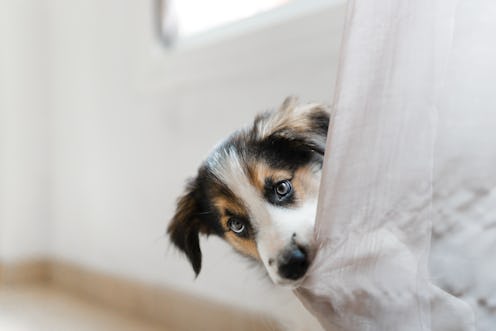Life
This Is Why Your Dog Makes A Guilty Face

If you have a pooch of your own (or at least an internet connection), you are probably already familiar with the "guilty dog look" — the heart-melting behavior wherein a pup bows its head, casts its eyes down, and radiates a contrite demeanor. As it turns out, there is actually a scientific explanation for your dog's guilty face — and it has to do more with evolution than an actual apology. The look is often employed when a dog seems to know it has done something naughty, such as peeing in an inappropriate place or using your favorite pair of shoes as a chew toy. According to a recent post on Psychology Today, your furbaby isn't actually sorry for tearing up the couch; it's mimicking ingratiating behavior from its wolf ancestors.
Nathan Lents, a professor of molecular biology, notes in the Psychology Today post that this chastened, guilt-ridden appearance is also called the "apology bow"; it plays an important role in the social interactions between members of a wolf community, as well as in human-dog relationships. It may be difficult to imagine your 12-pound fluff ball displaying some semblance of fearsome, wolf-like behavior, but the apology bow proves that your domesticated pooch is still very much a canine that just wants to be part of the pack. The dog shaming meme that came to prominence in 2012, where dogs are placed near signs detailing their bad behavior, can provide some excellent examples of the look, notes New York Magazine's Science of Us blog.
Animal behaviorists have observed that the guilty look is first displayed by young wolves as part of learning the social rules of the pack. When a juvenile has disobeyed a social rule, such as biting too hard during play, the offending wolf is shunned for its behavior. In order to be readmitted to the group, it must take on the posture of the apology bow and display its submissiveness.
Domesticated dogs, too, are adept at reading the moods of their human companions, and if they have offended, your pup is eager to please and be part of the pack once again. "Dogs have inherited this behavior and they will use it after any kind of infraction that results in being punished," Lents explains. "As social animals, they crave harmonious integration in the group and neglect or isolation is painful for them."
Wolves will also employ the apology bow to show submission "to a more dominant, higher-ranking wolf." Your pup and its wolf relative will put their tail between their legs, bow their head, and cease all panting or smiling. If you notice this behavior in your furbaby, you know it wants nothing more than to be back in your good graces. And one look at those sad puppy-dog eyes and it will be pretty hard to deny them (even if they did just eat all your special artisanal cheese).
Unfortunately, the apology bow does not guarantee that your pooch will never have another accident in the house, but when your pup grovels at your feet, at least you know who is really top dog.
Images: Rawlstock/Moment/Getty Images; Giphy
This article was originally published on